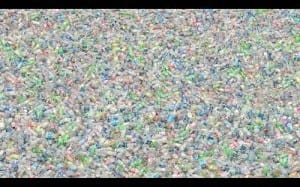
The collection of plastic remnants is having a surprising impact on marine life, according to recent findings
The Great Pacific Garbage Patch is having both expected and unexpected impacts on the ecology of the Pacific Ocean, according to researchers who travelled 1,000 miles from the California coast to document the effects of garbage of aquatic life.
The Great Pacific Garbage Patch is an enormous mass of floating plastic that has been dumped into the oceans, and through the many ocean and wind currents, it has decomposed to small, fingernail-sized pieces spread across thousands of miles of ocean between Hawaii and California. The garbage patch is formed from the release of thousands of tons of plastic waste into the oceans each year. It is estimated that the Great Pacific Garbage Patch has grown a hundred-fold in the past four decades.
It is no surprise that such extreme amounts of plastic in our oceans can have a detrimental impact on the ecology of marine creatures- what is surprising is just how such organisms are coping with our man-made waste.
Findings published Wednesday online in Biology Letters, a journal of Britain’s Royal Society, point to the realization that, like nearly all of Earth’s organisms, an equilibrium is being reached, in which marine creatures both suffer from the impacts of the plastic waste and also adapt.
The research was conducted by renowned oceanographers at the Scripps Institution of Oceanography. The marine scientists traveled 1,000 miles from the California coast to detail the impacts of the itsy-bitsy plastic pieces on marine life for a three-week period in August 2009. In addition to funding from the Scripps Institute, the expedition was also sponsored by the University of California and National Science Foundation.
The team of scientists used mesh nets to capture small plastic pieces. They also collected water samples and marine specimens at different depths during the course of their expedition.
The researchers were already aware from previous findings that nearly 10 percent of fish had ingested plastic pieces. According to the Scripps Institute, the study estimated that dish in the intermediate ocean depths of the North Pacific Ocean ingest plastic at a rate of roughly 12,000 to 24,000 tons per year.
In the U.S. alone, two million plastic beverage bottles are used every five minutes.
The team found that in addition to the plastic having a negative impact on the diets of marine creatures the plastic also serves another, even natural, function. The team, led by Scripps graduate students Miriam Goldstein, learned that a specific a marine insect that skims the ocean surface laying its eggs on natural floating objects such as driftwood or seashells is, in fact, using the floating plastic as a substitute. The scientists have not yet discovered any detrimental impacts of this change in the insect’s ecology, but they remain cautious about the role the plastic will play in the insect’s habitat.
As Goldstein stated, “This is something that shouldn’t be in the ocean and it’s changing this small aspect of the ocean ecology.”
The release of plastics into the world’s oceans is not something that will taper off anytime soon without serious changes in numerous nation’s waste-disposal processes. In fact, a similar mass of floating trash was recently found between Bermuda and the Portuguese Azores Islands in the Atlantic Ocean. Continued observation of the impacts of man-made waste on marine creatures is needed before the nations of the world are convinced dumping of waste into the oceans is just simply a bad idea. After all, how would we feel if fish dumped their waste on land?


















